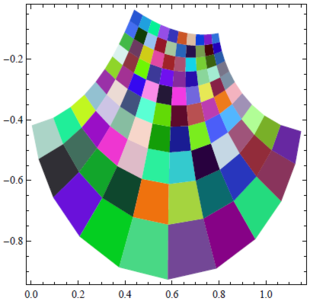|
|
| Line 24: |
Line 24: |
|
|
|
|
|
'''Approach 3: Find a Basis with the Decomposed Polynomial''' |
|
'''Approach 3: Find a Basis with the Decomposed Polynomial''' |
|
|
|
|
|
|
|
|
This approach is straightforward. Show that <math>S = \{x - a, (x - a)x, (x - a)x^2, ..., (x - a)x^{n - 1}\}</math> is a basis of <math>W</math>. |
|
|
|
|
|
|
|
|
'''Approach 4: Find a Basis without the Decomposed Polynomial''' |
|
'''Approach 4: Find a Basis without the Decomposed Polynomial''' |
|
|
|
|
|
|
|
|
This approach requires a little more cleverness when constructing the basis: <math>S = \{x - a, (x^2 - a^2), (x^3 - a^3), ..., (x^n - a^n)\}</math>. |
Revision as of 18:17, 29 November 2014
Welcome to Math 240!
(additions to this web site no longer count towards good deed points)
|
| #
|
Week of...
|
Notes and Links
|
| 1
|
Sep 8
|
About This Class, What is this class about? (PDF, HTML), Monday, Wednesday
|
| 2
|
Sep 15
|
HW1, Monday, Wednesday, TheComplexField.pdf,HW1_solutions.pdf
|
| 3
|
Sep 22
|
HW2, Class Photo, Monday, Wednesday, HW2_solutions.pdf
|
| 4
|
Sep 29
|
HW3, Wednesday, Tutorial, HW3_solutions.pdf
|
| 5
|
Oct 6
|
HW4, Monday, Wednesday, Tutorial, HW4_solutions.pdf
|
| 6
|
Oct 13
|
No Monday class (Thanksgiving), Wednesday, Tutorial
|
| 7
|
Oct 20
|
HW5, Term Test at tutorials on Tuesday, Wednesday
|
| 8
|
Oct 27
|
HW6, Monday, Why LinAlg?, Wednesday, Tutorial
|
| 9
|
Nov 3
|
Monday is the last day to drop this class, HW7, Monday, Wednesday, Tutorial
|
| 10
|
Nov 10
|
HW8, Monday, Tutorial
|
| 11
|
Nov 17
|
Monday-Tuesday is UofT November break
|
| 12
|
Nov 24
|
HW9
|
| 13
|
Dec 1
|
Wednesday is a "makeup Monday"! End-of-Course Schedule, Tutorial
|
| F
|
Dec 8
|
The Final Exam
|
| Register of Good Deeds
|

Add your name / see who's in!
|

|
|
Boris
Question 26 on Page 57 in Homework 5
Let  and
and  be a subspace of
be a subspace of  . Find
. Find  .
.
First, let  . Then we can decompose
. Then we can decompose  since there is a
since there is a  such that
such that  . From here, there are several approaches:
. From here, there are several approaches:
Approach 1: Use Isomorphisms
We show that  is isomorphic to
is isomorphic to  . Let
. Let  be the standard ordered basis of
be the standard ordered basis of  and
and  be a subset of
be a subset of  . Then there is a unique linear transformation
. Then there is a unique linear transformation  such that
such that  where
where  . Show that
. Show that  is one-to-one and onto and conclude that
is one-to-one and onto and conclude that  .
.
Approach 2: Use the Rank-Nullity Theorem
Let  be the standard ordered basis of
be the standard ordered basis of  and
and  . Then
. Then  where
where  and
and  . Define
. Define  by
by  . Then it is easy to show that
. Then it is easy to show that  is both well-defined and linear. Afterwards, show that
is both well-defined and linear. Afterwards, show that  and use the rank-nullity theorem to conclude that
and use the rank-nullity theorem to conclude that  .
.
Approach 3: Find a Basis with the Decomposed Polynomial
This approach is straightforward. Show that  is a basis of
is a basis of  .
.
Approach 4: Find a Basis without the Decomposed Polynomial
This approach requires a little more cleverness when constructing the basis:  .
.





























